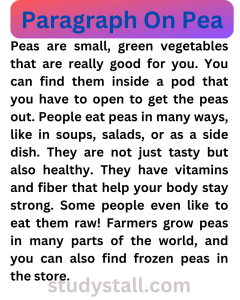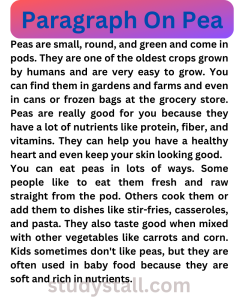Pea, scientifically known as
Pisum sativum, is a versatile and nutritious legume that has been cultivated for thousands of years. This small, spherical, and green seed is not only a popular ingredient in various cuisines around the world, but it also offers numerous health benefits. In this article, we will explore the various aspects of peas, including their history, cultivation, nutritional value, culinary uses, and potential health benefits.
Paragraph On Pea 100 words
Peas are small, green vegetables that are really good for you. You can find them inside a pod that you have to open to get the peas out. People eat peas in many ways, like in soups, salads, or as a side dish. They are not just tasty but also healthy. They have vitamins and fiber that help your body stay strong. Some people even like to eat them raw! Farmers grow peas in many parts of the world, and you can also find frozen peas in the store.
Paragraph On Pea 200 words
Peas are small, round, and green and come in pods. They are one of the oldest crops grown by humans and are very easy to grow. You can find them in gardens and farms and even in cans or frozen bags at the grocery store. Peas are really good for you because they have a lot of nutrients like protein, fiber, and vitamins. They can help you have a healthy heart and even keep your skin looking good.
You can eat peas in lots of ways. Some people like to eat them fresh and raw straight from the pod. Others cook them or add them to dishes like stir-fries, casseroles, and pasta. They also taste good when mixed with other vegetables like carrots and corn. Kids sometimes don’t like peas, but they are often used in baby food because they are soft and rich in nutrients.
Paragraph On Pea 300 words
Peas are a type of vegetable that are both tasty and good for you. They are small, usually green, and grow in a pod. Each pod can have many peas inside it. People have been growing peas for thousands of years, and they are one of the oldest plants that humans have farmed. You can find them in almost any grocery store, either fresh, canned, or frozen.
What’s great about peas is that they are full of good stuff like fiber, protein, and vitamins like Vitamin C and K. This means they are good for your heart, your skin, and even your bones. Doctors often say that eating vegetables like peas can help you stay healthy.
Peas are also very flexible in cooking. You can boil them, steam them, or even microwave them. They are a common ingredient in many dishes. You can find them in pot pies, pasta, and rice dishes. They blend well with many flavors and can be spiced up with herbs and spices.
But peas are not just for eating! People also use them for other things. For example, some people use dried peas to fill bean bags or to make crafts. In some countries, throwing peas is a tradition during certain celebrations.
So, whether you’re eating them, cooking with them, or using them in crafts, peas are a small but mighty vegetable that has a lot to offer. They are easy to find, easy to cook, and most importantly, good for your health.
Paragraph On Pea 500 words
History and Cultivation
Peas have a rich history that dates back to ancient times. They are believed to have originated in the Mediterranean region and were widely cultivated in ancient Egypt, Greece, and Rome. Peas were highly valued by ancient civilizations due to their nutritional content and ability to thrive in different climates.
Today, peas are grown in many parts of the world, including Europe, North America, and Asia. They belong to the legume family and are known for their ability to fix nitrogen in the soil, making them an excellent crop rotation option for farmers. Peas can be categorized into three main types: garden peas, snow peas, and snap peas, each with their own unique characteristics and culinary uses.
Nutritional Value
Peas are not only delicious but also packed with essential nutrients. They are a rich source of vitamins, minerals, and dietary fiber. A 100-gram serving of peas contains approximately:
- Calories: 81
- Protein: 5.4 grams
- Carbohydrates: 14.5 grams
- Fiber: 5.1 grams
- Fat: 0.4 grams
- Vitamin C: 40% of the recommended daily intake
- Vitamin A: 11% of the recommended daily intake
- Iron: 5% of the recommended daily intake
Culinary Uses
Peas are incredibly versatile in the culinary world and can be enjoyed in various forms. Here are some popular culinary uses of peas:
- Soups and stews: Peas add a delightful sweetness and vibrant green color to soups and stews. They can be pureed or used whole, depending on the desired consistency.
- Salads: Fresh or blanched peas make a fantastic addition to salads, providing a crunchy texture and refreshing flavor.
- Stir-fries: Snow peas and snap peas are often used in stir-fries due to their tender texture and ability to retain their shape when cooked.
- Side dishes: Peas can be served as a delicious side dish, either on their own or combined with other vegetables. They can be sautéed, roasted, or steamed for a quick and healthy option.
- Mashes and purees: Peas can be mashed or pureed to create a creamy and flavorful base for various dishes, such as dips, spreads, or even as a substitute for mashed potatoes.
Health Benefits
Including peas in your diet can offer several health benefits. Here are some potential advantages:
- Rich in antioxidants: Peas contain various antioxidants, such as flavonoids and carotenoids, which help protect the body against free radicals and oxidative stress.
- Good source of fiber: The fiber content in peas promotes healthy digestion, prevents constipation, and supports gut health.
- Heart-healthy: Peas are low in fat and cholesterol, making them an excellent addition to a heart-healthy diet. They also contain compounds that may help lower cholesterol levels.
- Blood sugar regulation: The fiber and protein content in peas can aid in blood sugar regulation and prevent spikes in glucose levels.
- Weight management: Being low in calories and high in fiber, peas can help with weight management by promoting feelings of fullness and reducing overall calorie intake.
Conclusion
In conclusion, peas are a wonderful addition to any diet due to their versatility, nutritional value, and potential health benefits. Whether used in soups, stir-fries, salads, or enjoyed on their own, peas offer a burst of flavor and a wealth of nutrients. So, next time you’re planning your meals, consider incorporating peas for a delicious and nutritious boost.
Pea FAQ
- What is the nutritional value of peas?
- A 100-gram serving of peas contains approximately 81 calories, 5.4 grams of protein, 14.5 grams of carbohydrates, 5.1 grams of fiber, 0.4 grams of fat, 40% of the recommended daily intake of Vitamin C, 11% of the recommended daily intake of Vitamin A, and 5% of the recommended daily intake of iron.
- How can peas be used in culinary dishes?
- Peas are incredibly versatile and can be used in various culinary dishes. They can be added to soups and stews, used in salads for a crunchy texture, included in stir-fries, served as a side dish, or mashed and pureed.
- What are the different types of peas?
- Peas can be categorized into three main types: garden peas, snow peas, and snap peas. Each type has its own unique characteristics and culinary uses.
- What is the history and cultivation of peas?
- Peas have a rich history that dates back to ancient times. They are believed to have originated in the Mediterranean region and were widely cultivated in ancient Egypt, Greece, and Rome. Today, peas are grown in many parts of the world, including Europe, North America, and Asia. They are known for their ability to fix nitrogen in the soil, making them an excellent crop rotation option for farmers.




